How to Engineer Better AI Prompts for Your SEO Content Production—With Examples
Topic: SEO
Published:
Written by: Bernard Huang
When I first started out as a young millennial marketer in content strategy and SEO, we didn't have the luxury of tools like ChatGPT or AI models to streamline our processes.
Queue up a "back in my day..." lecture.
Every keyword, every piece of content, and every optimization required hours (and hours) of research and manual effort.
Today, AI-powered tools have completely transformed the way we all approach SEO and digital marketing. And they did it fast.
But here's the thing: The real game-changer isn’t just using AI—it’s about knowing how to engineer effective prompts to get the best possible output... all while remaining steadfast in providing people-first, high-quality content.
If you’re like me, you want to maximize your results without wasting time.
That’s where prompt engineering comes into play.
(And if you’re also a seasoned marketer like me and want to expertly skip a pitch, jump ahead to the implementable tips by scrolling to the next heading below.)

You're invited to our next Clearscope Webinar with top industry experts. And it's going to be a good one.
In this guide, I’ll show you how to write smarter prompts to level up your SEO content strategy and even give you a few that we use in-house on the Clearscope team.
Whether you're optimizing for long-tail keywords, refining meta descriptions, or generating blog ideas, mastering prompt engineering will allow you to get the most out of AI tools like ChatGPT and boost your search engine rankings faster than ever before.
But I’m not going to recommend any AI content writing tools in this article—and I’m not going to advertise any courses or solicit your email to access templates.
There are no affiliate links in this article, and I’m not going to try and sell you anything.
But I am going to recommend that you think about demoing Clearscope if you haven’t before, because it streamlines your content production and comprehensively monitors your content’s health...
...which is also the whole point of better prompt engineering for SEO content—creating better content and streamlining workflows to get more out of your time.
Clearscope is NOT an AI content generation tool. It’s the content-first SEO platform that will help you grow and protect your hard-earned organic visibility.
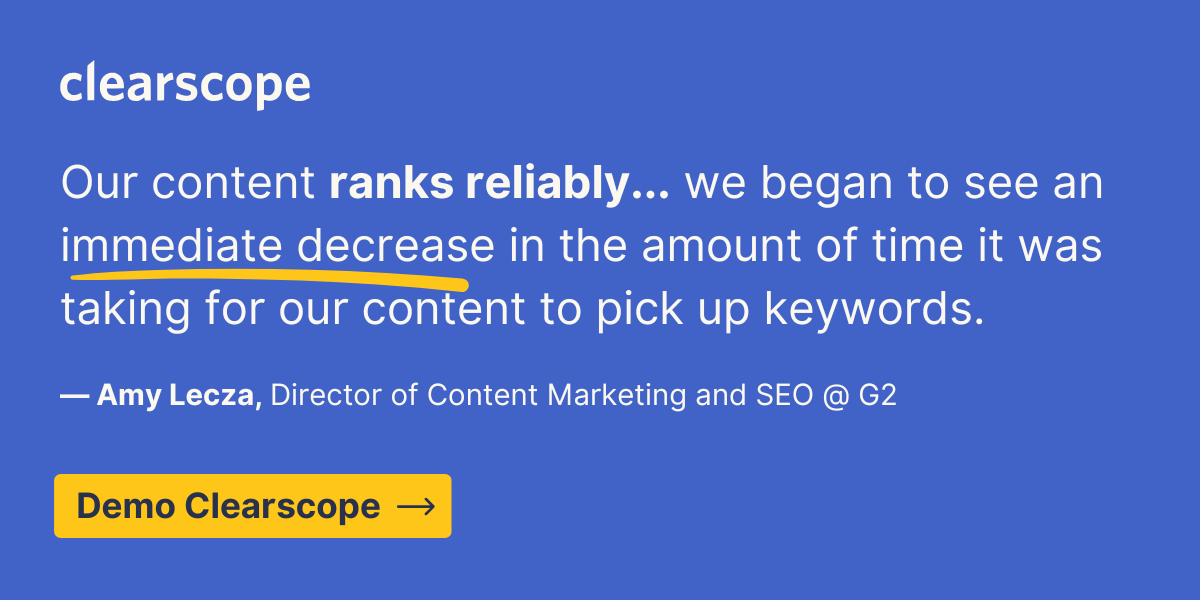
A note on prompt engineering for the AI-content-averse
Not sure about incorporating AI tools and AI-assisted content in your content marketing strategy or production practices?
A word of advice here: As SEO professionals, we need to be continuously growing and adapting as technology changes.
In today’s competitive landscape, achieving strong search engine optimization (SEO) results on a tight budget is crucial for many content creators.
In fact, 75% of CMOs in 2023 reported needing to accomplish more with fewer resources (source: Gartner).
This is where artificial intelligence (AI) tools—like Google’s Gemini, ChatGPT (aka GPT-4) from OpenAI, Claude, or Perplexity.AI—step in to support tasks like copywriting, content creation, and SEO.
READ MORE: Should you use AI-generated content in your SEO strategy?
Natural language processors (NLPs) and artificial intelligent apps aren’t the enemy—but we do need to use them wisely and thoughtfully in SEO content brainstorming and production.
Artificial intelligence is an excellent tool that can speed up your processes, and offer an excellent starting point for content outlines or drafts.
However, the real secret to unlocking the power of these chatbots for SEO-friendly content is all in how you use them... the power lies in mastering prompt engineering to produce AI-assisted content vs. AI-generated content.
To get the best from AI content tools, you need to design effective prompts that guide the language model to produce the highest-quality output possible with a focus on people-first content and EEAT guidelines.
Whether you're writing meta descriptions or drafting a landing page, your prompts should provide clear directions and specific instructions to improve readability, relevance, and alignment with user intent.
Chima Meje of Moz explains on this Clearscope Webinar how to use AI-generated content and thought leadership to stand out from the consensus.
Example: How good prompt engineering makes a difference
If you ask ChatGPT to “list blog ideas” for topics in your niche, it might return a broad array of topics.
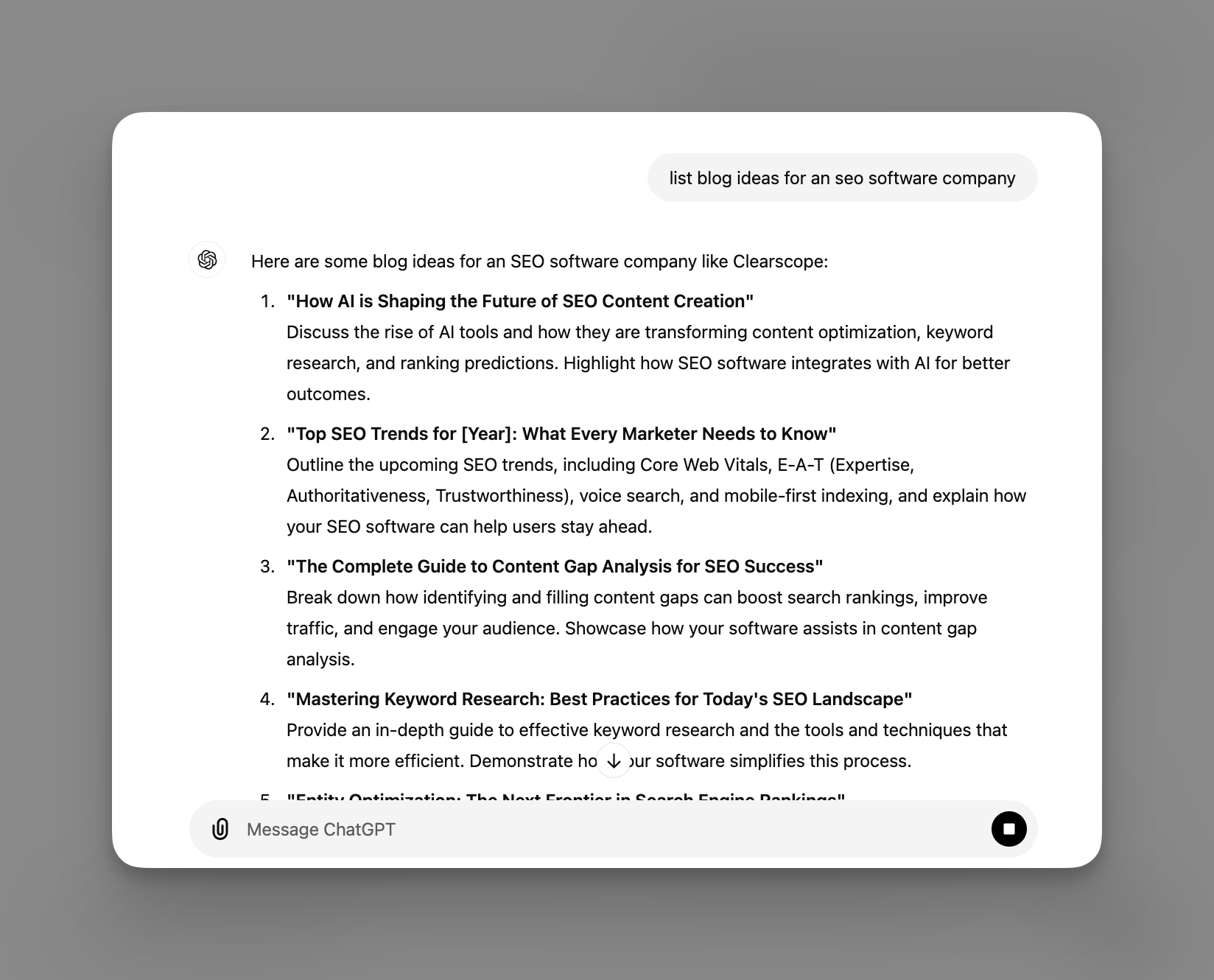
This image of my use of a simple prompt with ChatGPT convo demonstrates the bland output provided by my bland input. The offered suggestions lean toward content that’s already been done.
That looks like a lot of consensus content (or copycat content) ideas to me.
So let’s think about this differently—through the lens of information gain.
Let’s say you and your team developed a case study for one of your clients, which is unique information that only you can develop. You’d like to create an SEO-friendly blog article that houses the data and findings in the case study.
For your prompt, if you specify the search intent, audience, and content types, you'll end up with a prompt like “Generate 5 SEO-friendly blog topic ideas to publish results of an in-depth case study targeting small businesses focused on machine learning.” Now, the AI can return much more relevant ideas.
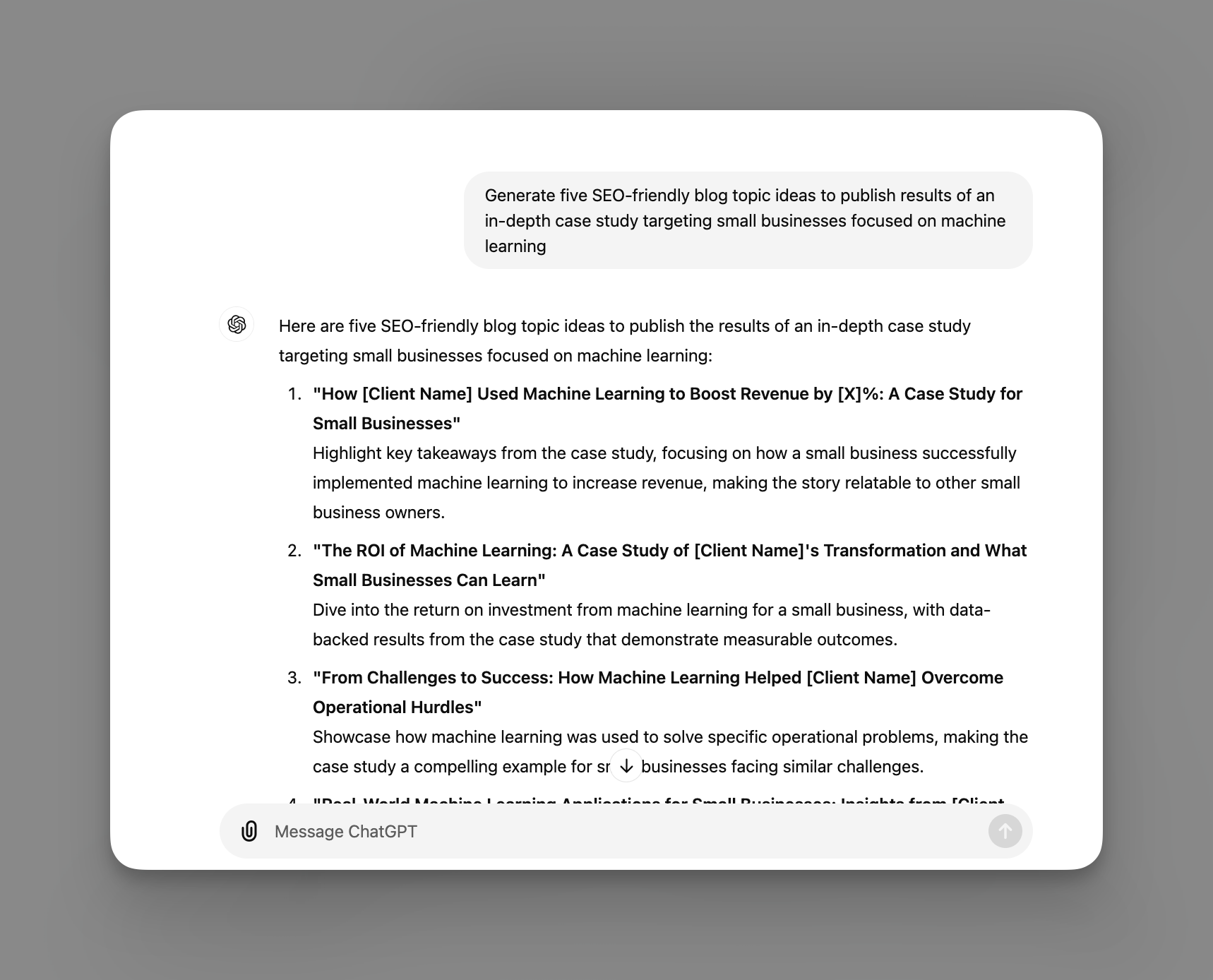
A better prompt often earns a better, more interesting output.
This is how refining your writing prompts leads to better, more actionable output that aligns with your SEO strategy.
4 key components to writing better SEO prompts
To get high-quality results from your AI content, writing your prompts should be an important step in your overall workflow and production process.
Yes, you can template-ize (or save your configurations as custom GPTs) and reuse them in the future.
But you’re going to get the best result if you think about AI prompt engineering as an important task in creating your SEO content—not just a side-step.
Make sure to include:
Instructions: Detail clear actions like "write a blog intro from first-person perspective" or "generate a CTA that’s engaging, sends the user to [next step], and is related to [article draft]"
Context: Provide details that give good context for the AI to work from, like the target audience or search intent.
Input data: If relevant, provide content to be processed, such as a specific web page, report, spreadsheet of data, or a paragraph.
Output indicators: Use indicators like word count, format (e.g., bullet points), or specific header instructions.
Examples: Optimizing SEO prompts for better content creation across 7 use cases
Okay, let’s put the four components above to work with a few examples across 7 different use cases:
1. Keyword research and optimization prompts
When using AI tools for keyword research, the more detail you provide, the better the result.
Include details like search volume, search intent, and related topics.
Example 1:
Generic prompt: Generate a list of keyword ideas about social media influencer software.
Better prompt: Generate a list of SEO keywords for an educational article about software options for finding social media influencers for marketing campaigns. The target audience is decision makers on marketing teams with a high search intent to make a purchase decision. Use this seed keyword [social media influencer software] to generate a list.
Example 2:
Generic prompt: Generate a list of long-tail keywords for architectural services
Better prompt: Generate a comprehensive list of long-tail keywords for architectural services that reflect a local commercial search intent by high income households.
2. Competitor keyword and content analysis prompts
Clearscope will do in-depth content analysis, entity research, and keyword recommendations directly in our platform automatically as you work on a piece of content—you don’t need to seek out AI guidance unless you want to.
But if you’re not a Clearscope user, here are a few examples of the prompt approach I’d recommend:
Example 1:
Generic prompt: I want to rank for [keyword or topic]. Make a list of [competitors, search queries, or topics] in this topic and tell me their keyword strategy.
Better prompt: Analyze the top-ranking content for [competitor, search query, or topic] and identify gaps or opportunities in their keyword strategy for [specific search intent] that I can target on my site [insert site] to improve organic visibility.
Example 2:
Generic prompt: I want to rank for [keyword or topic]. What are my content competitors writing about? Give me a list of 10 ideas that I haven’t covered on my site [insert site].
Better prompt: Develop an entity-rich keyword strategy for [specific industry, topic, or search query], incorporating primary and secondary entities to enhance semantic search optimization and improve content relevancy compared to [insert competitors].
Again, you can skip this step entirely with Clearscope; the platform guides you in exactly what you need to do to create people-first content that ranks in real-time while you write.

3. Prompts for SEO-focused outline generation
If you have Clearscope, you can also skip this step because Clearscope will create an AI-generated SEO-focused outline (one that’s crafted to sharply meet your target search intent) right within the platform.

Here's how you can create an AI-generated outline directly in the Clearscope platform as you work.
But if you don’t use Clearscope, below is a prompt to help speed along the content outline process:
Generic prompt: Create an outline for an article optimized for [topic/keyword].
Better prompt: Generate an SEO-optimized outline for [type of content: a how-to guide, comparison article, roundup article, pillar page, thought-leadership piece, study or analysis report] on [topic/keyword]. The target search intent is [insert search intent] and the target reader is [insert target audience]. Style instructions: [Break down the main steps or sections, use sentence case, ensure synonymous use of the target keyword.]
4. Meta description and title tag prompts
Optimizing meta descriptions and title tags is an important piece of SEO hygiene.
And if Google doesn’t select it’s own version for the page, your mindfully crafted meta data can be instrumental in boosting your click-through rates.
Use output indicators like word count or a focus on target audience to get more refined suggestions.
Example 1:
Generic prompt: Write a 160-character meta description for the blog post below [copy and insert text]
Better prompt: Write a 160-character meta description for a blog post below using the relevant keywords [insert keywords]. The search intent is to [purchase a service], and the target audience is [CEOs of manufacturing companies]. [copy and insert article text]
Example 2:
Generic prompt: Write a 65-character meta title for the blog post below [copy and insert text] that includes the relevant keywords [insert keywords]
Better prompt: Write a 160-character meta description for a blog post below using the relevant keywords [insert keywords]. Style notes: The title should be [highly engaging and clickable, without being spammy]. The search intent is to [purchase a service], and the target audience is [CEOs of manufacturing companies]. [copy and insert article text]
5. Prompts for generating FAQs
FAQs help target long-tail keywords and address common questions.
A detailed prompt can provide better, more specific results.
Generic prompt: List 5 FAQs for a blog about [insert topic or target queries]
Better prompt: List 5 unique questions for a blog about [insert topic or target queries] with the target audience of [insert audience and search intent]. Currently, our customers and sales teams have [insert customer question or issue]. With the questions you create, please expand on that need and how it relates to this [insert topic or target queries].
Pro tip: When you run a Clearscope draft for a piece of content, the draft provides you a list of FAQs that are found across your content competitors on the Research tab.
Many of our Clearscope clients like to use this list as a starting point. If you copy and paste it into your favorite generative AI chat platform, you can use this list to create even more specific and unique questions—which is key if you want to differentiate your content from your competitors.
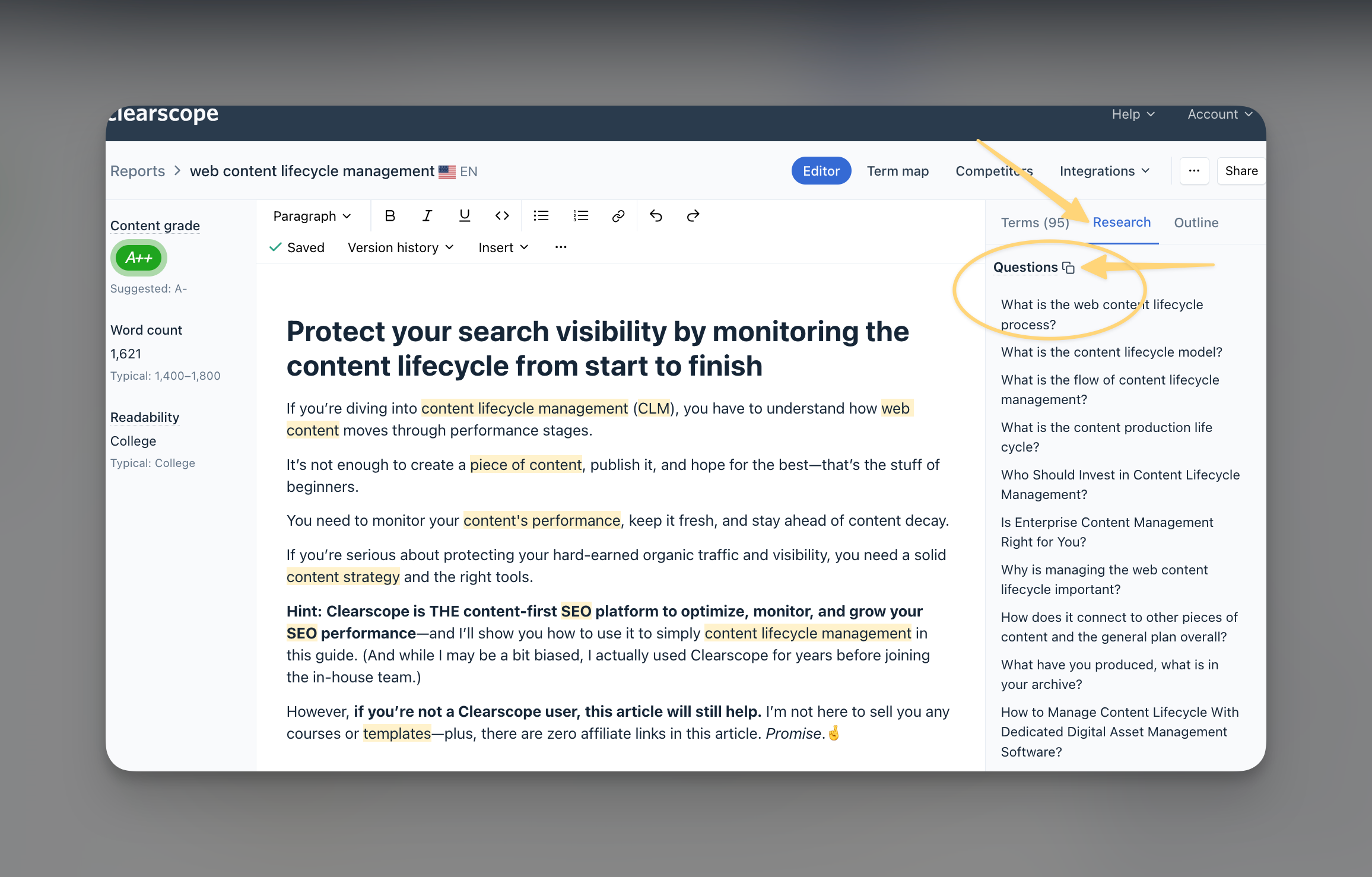
For this successful FAQ generation tactic, our team likes to use the following prompt:
Prompt: Below is a list of FAQs on [topic / query / pain point / product / service]. Can you create 10 more unique questions that are not included on this list and focus on [user intent] for [audience]?
Example inputs: Below is a list of FAQs on the topic of content lifecycle management. Can you create 10 more unique questions that are not included on this list and focus on a commercial intent for marketing team decision makers?
Using the example input above and Google Gemini, I was able to get a really solid list.

Google Gemini output when requesting highly detailed and specific FAQ generation for content creation purposes.
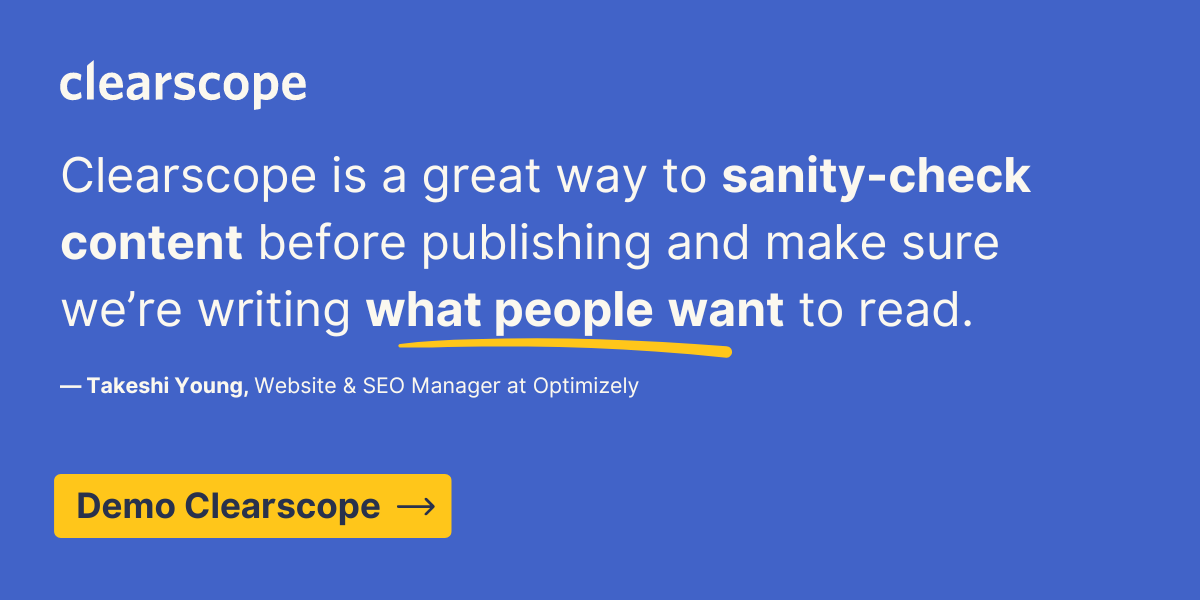
6. Prompts for writing CTAs
Every seasoned marketing and SEO expert knows a strong call to action (CTA) can drive engagement and improve conversion rates.
You can guide AI to create compelling CTAs by being specific about tone and outcome.
Generic prompt: Create a short, persuasive CTA encouraging readers to [action].
Better prompt: Create a [specific output indicators, like word count, character count, or style] CTA encouraging [audience] to [action] for the [content type] below. [insert content text]
7. Prompts for generating content assistance
I’m a big fan of a AI-assisted content (instead of purely AI-generated content), which means I might have an AI tool help me generate small pieces of copy—like descriptions for e-commerce pages or subheading suggestions for an article section.
But I’m not going to rely on it for my final draft in the majority of use cases.
Why?
Because I don’t want to produce the exact same consensus content that everyone else is producing.
I might use some of the prompts below to generate a first draft, some keyword optimization, or a small section of an article, but I’ll do the final editing with a focus on user experience and, you know, being a human.
Here are some prompts I like to use that stay away from generics in order to get a better output:
Generating a section of an article
Prompt: Generate [paragraph, bulleted list, 5-step plan] for [insert need, like sub-section heading, FAQ, pain point]. Keep in mind that the the search intent is [insert search intent], the target search query is [focus keyword] and the target reader is [insert target audience]. Draft this copy in the style of [insert style]. Be sure to include [insert data, report, information gain].
Example inputs: Generate a [paragraph] a for [How can content lifecycle management improve our ROI on content marketing campaigns?]. Keep in mind that the the search intent is [commercial], the target search query is [content lifecycle management] and the target reader is [marketing team decision makers]. Draft this copy in the style of [a millennial marketing expert]. Be sure to include [the report below].
Generating an SEO-friendly e-commerce page
Prompt: Write a compelling, SEO-friendly product description for [product name], focusing on its key features, benefits, and unique selling points. Incorporate relevant keywords like [target keywords] to improve search visibility. Keep in mind that the the search intent is [insert search intent], the target search query is [insert query] and the target reader is [insert target audience]
Generating SEO-friendly headings and subheadings
Prompt: Write a compelling, SEO-friendly [heading, subheading, title] for the content included below. Incorporate relevant keywords like [target keywords] to improve search visibility. Keep in mind that the the search intent is [insert search intent], the target search query is [insert query] and the target reader is [insert target audience] Draft this copy in the style of [insert style]. [insert content]
Limitations of AI for SEO
While AI tools like ChatGPT can speed up the content creation process, you’re probably already aware that they're not a replacement for human expertise in areas like:
Your topic’s subject matter
Understanding real-time changes in search engine algorithms
Factual accuracy
Unique thought
New perspectives
Keep in mind, AI may sometimes hallucinate or provide incorrect data, which is why it's important to follow-up with manual adjustments or a fact-check by a subject matter expert.
Pair AI-generated content with SEO tools like Clearscope (we offer Wordpress, Google Docs, and Microsoft Word integrations) to ensure your expert-created, people-first content is both accurate and optimized for optimum visibility on the SERPs.

May 2024 Clearscope Webinar audience survey: 68.7% of our audience believed ChatGPT to be the most reliable and trustworthy while 9.9% believed Gemini was most reliable and 21.4% find other AI chat tools to be the most reliable.
Final tips and tricks: Improving your prompt engineering for SEO
Here are some tactics for writing better ChatGPT prompts to optimize your SEO content:
Iterate: If the first response isn’t what you need, tweak the prompt by adding more context or details. You can ask for a follow-up to fine-tune the content.
Try different models or tools: Experiment with different AI tools to determine what produces the best outputs for your specific needs and industry. In May 2024, we polled our Clearscope Webinar audience—primarily made up of SEOs and content marketers—to see what they thought about AI content. Out of the 168 who responded, 68% felt that ChatGPT was the most reliable and trustworthy out of the AI chat models. However, these tools are rapidly improving, so run tests to determine what works best for you.
Use templates: For frequently performed tasks, such as generating meta descriptions, create prompt templates that can be easily reused. Create custom GPTs or a “prompt bank” in a shared file to provide to your team to get consistent results across users.
Provide specific details: As mentioned above, good prompt engineering results in better outputs, and to get better outputs, well, sometimes you need more detailed inputs!

Contributing authors and updates
The original version of this article was published August 8, 2023, by Bernard Huang. It was revised on October 21, 2024, by Amanda Johnson of the Clearscope team to include updated education and analysis of current best practices.
Should You Use Ai-Generated Content in Your SEO Strategy?
If you’re looking for ways to save time, AI content generation is a tempting option. But does it work? Should you use it? Check out our guide to learn more.
Read more11 best AI content writing tools (reviews included!)
What is the best AI tool for content creation? I tested plenty of the most popular AI content writing tools so you don't have to.
Read moreIntroducing: Clearscope's Draft with AI Feature. Designed for Humans. Enhanced with AI.
Discover Clearscope’s new draft with AI feature—an SEO-optimized, real-time content creation assistant built into your workflow. Draft high-quality, plagiarism-free blog posts faster with customizable tone, structure, and intent.
Read more